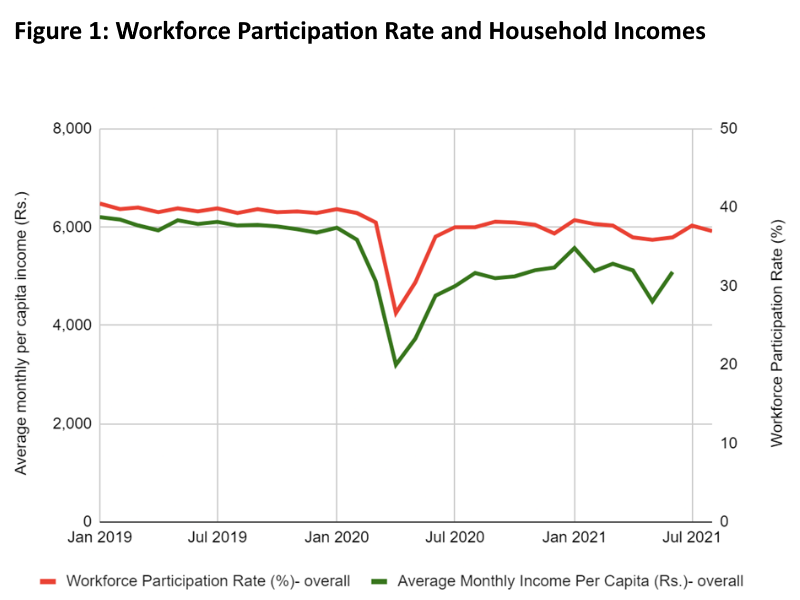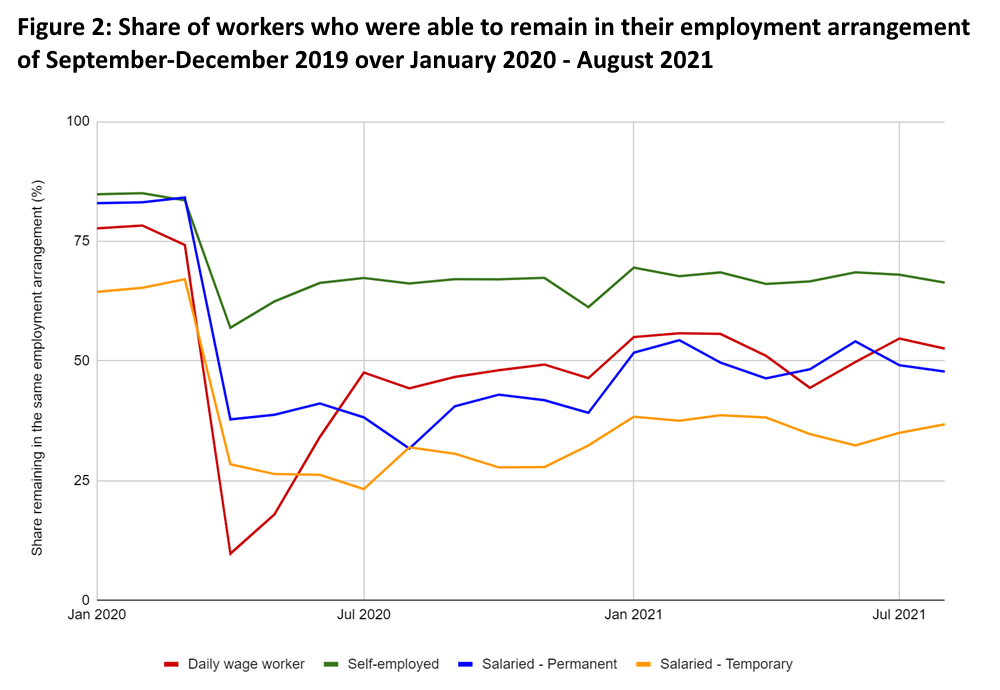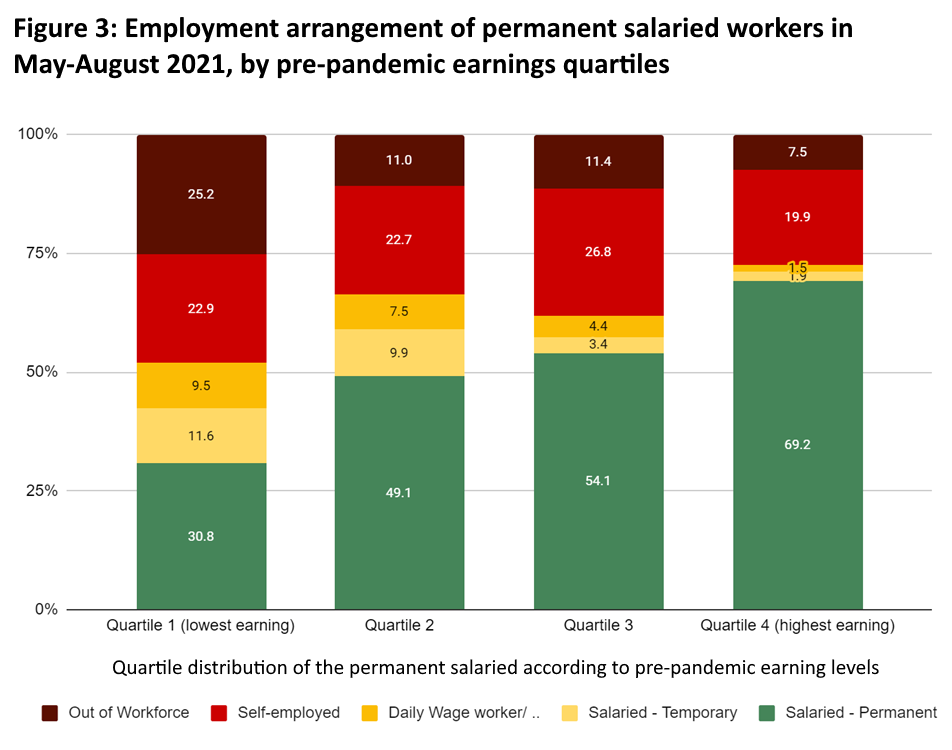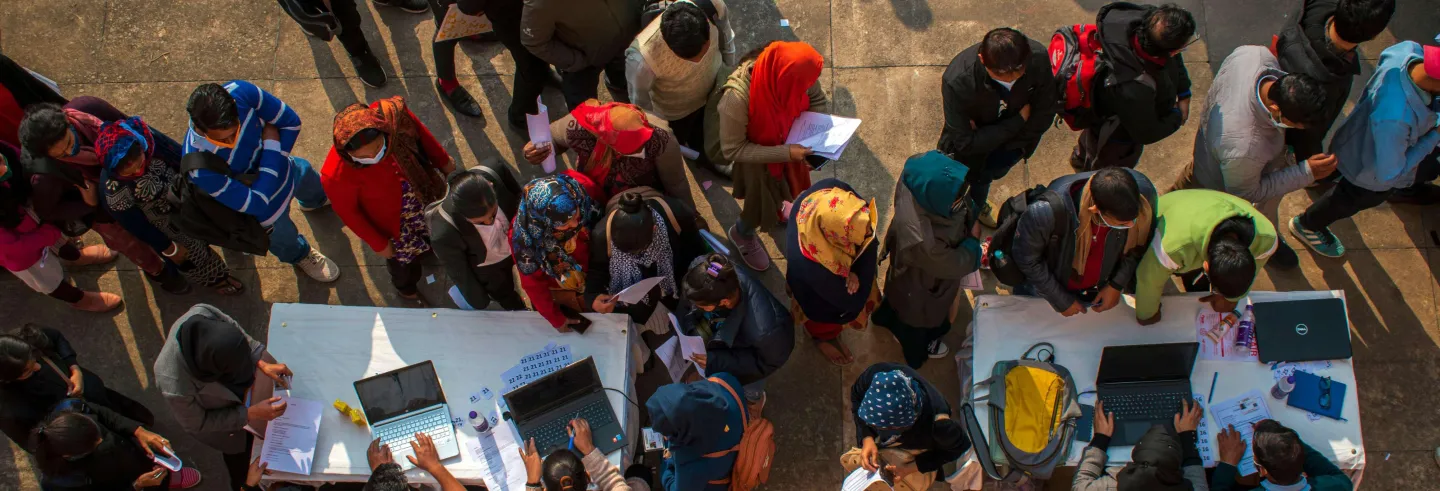Barring a serious third wave of infections, India’s gross domestic product (GDP) is expected to recover to its pre-pandemic level in the financial year (2021-22) that ends on 31 March. But the pandemic has caused an unprecedented and persistent disruption in the labour market. The first wave and its associated containment measures in 2020 resulted in millions losing their livelihoods and a massive increase in poverty (State of Working India 2021).
Multiple independent surveys at the local and national level have shown continuing low employment rates, reduced incomes, increased food insecurity, and elevated debt levels. Most recent data from the Centre for Monitoring Indian Economy-Consumer Pyramid Household Survey (CMIE-CPHS) shows that in April 2021, incomes as well as employment remained below their pre-pandemic levels when the second wave arrived, causing more distress. As of the middle of 2021 (after the second wave), the employment rate remained 3 percentage points below its pre-pandemic value (i.e. roughly 10–12 million fewer workers were employed). Household incomes too had not fully recovered, but were stagnant at around 80% of their pre-pandemic levels (Figure 1).

A second salient aspect of the pandemic’s impact on labour markets is an increased level of informality. Amidst the ongoing debate over the extent of formalisation of the Indian economy (a major policy goal of the central government), it is worth noting that the sudden loss of work during the pandemic forced a fraction of salaried workers to fall back on self-employment as well as casual wage work, or to withdraw from the workforce entirely, thereby increasing the size of the informal sector.
As per CMIE-CPHS data, the share of self-employed and casual wage workers in the total workforce increased to 80% in 2020-21 from 78% in the years prior to the pandemic. Data from the Periodic Labour Force Survey also support this conclusion of a rise in self-employment. Some of these effects are likely to be temporary and as the economy recovers, salaried workers are expected to go back to their pre-pandemic work arrangements. But this is by no means certain.
We have tracked workers in the CMIE-CPHS panel before and during the pandemic. 1 The Centre for Monitoring Indian Economy (CMIE)’s Consumer Pyramid Household Survey conducts tri-annual surveys of a selected panel of households recording information on their demographics, employment status, incomes and consumption expenditures among other aspects. Being a panel survey, i.e. it interviews the same individuals each time, the CMIE-CPHS allows us to track selected workers over time. Several concerns have been raised on this CMIE data including the survey design, sampling strategy and the representativeness of the sample. However, these concerns notwithstanding, the CMIE remains the only large-scale labour market survey that existed before the lockdown and has managed to continue operations during the lockdown and afterwards. For the purpose of this analysis, we have tracked those workers who were in permanent salaried jobs, pre-pandemic, i.e., the final wave of 2019. This constitutes an unweighted sample of 28,988 individuals who are then tracked over the next two years. Even in normal times, this data reveals a lot of flux in the labour market as workers move between employment arrangements. For example, let us take the case of “permanent salaried workers,” who have the most secure jobs among all workers. They accounted for about 11% of the workforce in the months before the pandemic and were largely employed (primarily as white collar professional and clerical employees) in the services sector: in public administration, professional services, and financial services. Over a period of a few months in a typical pre-pandemic year, about 80% of permanent salaried workers remain in the same employment arrangement, while the remaining move into self-employment or out of the workforce. But if we follow them for a year and half (from the end of 2017 to the beginning of 2019), this number drops to only 50%. The level of churn is even higher for temporary salaried workers and daily wage workers.
Adding to this instability, the pandemic contributed a series of shocks. Restricting our sample to those workers who were employed in the months of September-December 2019 (the last CPHS wave of 2019), Figure 2 tracks how many of these workers remained in their initial type of employment in the months afterwards.
[T]he sudden loss of work during the pandemic forced salaried workers to fall back on self-employment as well as casual wage work, or to withdraw from the workforce entirely...
In April 2020, as the country found itself in one of the most stringent lockdowns, only 38% of permanent salaried and 28% of temporary salaried workers were able to hold on to these jobs. The nature of this transition was distinct across men and women with nearly half of women being pushed out of work, compared with only a quarter of men (data not shown). A year and a half later, only 48% of these permanent salaried workers were able to retain or come back to the same kind of employment. The rest continued in informal work (largely men) or left the workforce (largely women). In contrast, while daily wage workers were much worse affected initially, they were also able to come back to daily wage work to a larger extent (as indicated by the V-shaped curve). This is expected given the ease of entry and exit that characterizes daily wage labour markets.

As might be expected, better paid salaried workers were more likely to retain their employment. We categorise permanent salaried workers in terms of their pre-pandemic (September-December 2019) earnings into four quartiles, identifying the highest and least paid salaried workers. Within each quartile, these pre-pandemic salaried workers are categorised based on what their employment arrangement had become by May to August 2021. So, for instance, within the highest paid salaried workers, we are able to discern if by May–August 2021 this group of workers were able to remain in salaried work, or if they transitioned to another kind of employment, or if they withdrew from the workforce entirely.
The Indian economy has remained stubbornly informal over the past few decades… with the share of self-employment and casual wage work falling more slowly than expected.
Within Quartile 1 (the lowest paid salaried workers), nearly a quarter lost their jobs and could not return to work. Only three in ten permanent salaried workers were able to remain in salaried employment. Contrast this with the highest paid salaried workers (Quartile 4). Within this population of workers, seven out of ten were able to remain in permanent salaried employment and only about 8% were forced to withdraw from work.

In many developing countries, including India, it has been argued that the salaried or formal workforce is heterogenous, often characterised as having two tiers—one having highly secure and regular jobs with social security benefits, and the other having the most basic of salaried arrangements, with far more tenuous employment security, nearly akin to informal employment. This is apparent when looking at the differential impact of the lockdown and mobility restrictions. The higher earning salaried workers, the so-called ‘upper tier’, were able to retain their salaried work unlike the poorer salaried workers.
Besides a differential rate of exit by earnings level, there was also far higher exit among the younger workers. This reflects the higher vulnerability of the younger workers to job loss, as is seen in other sectors and employment arrangements too. By the end of 2019, the average age of permanent salaried workers was around 40 years. However, by the middle of 2021, the age of those who remained in permanent salaried work had increased to 42 years.
The Indian economy has remained stubbornly informal over the past few decades, despite high rates of GDP growth, with the share of self-employment and casual wage work falling more slowly than expected. This already slower-than-desired process of structural transformation has been reversed by the pandemic. The proportion of salaried workers in the workforce has fallen and that of self-employed workers has risen. Part of the reversal is likely to turn out to have been temporary as economic activity resumes and workers return to their pre-pandemic jobs. However, two factors may create significant headwinds in this process. First, anecdotal evidence suggests that firms have taken this opportunity to restructure their workforce and increase levels of automation. Second, persistent softness in the labour market and depressed levels of income imply weak aggregate demand, which, in turn, stifles investment. This can lock the workforce into its present state for long, if new jobs are not created in desired numbers.
The relief measures enacted in 2020 helped stave off the worst effects of the pandemic on vulnerable households. More needs to be done in the months to come to ensure a broad-based recovery in 2022. The upcoming budget of the government of India provides an opportunity to address this issue by increasing spending directed towards lower income households who have borne the brunt of the crisis.











